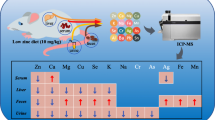Abstract
Twenty-six normal, 38 moderately and 14 severely zinc-deficient children, aged 2–12 years, were examined by clinical and laboratory approaches. After fasting-blood sampling, 120 mg zinc sulphate (25 mg elemental zinc) were administerd orally to each group of children, to obtain zinc tolerance curve patterns. Sampling proceeded to the 2nd and 4th hours of the loadingtest period. Plasma zinc was assessed on an atomic absorption spectrophotmeter. In normal children, at the 2nd hour of loading, a significant (p < .001) elevation (1.764 ± 0.133 mg/l) in the mean (± SEM) plasma zinc level was noted; also at the 4th hour a significant (p < .001) decrease (1.506 + 0.123 mg/l) in the mean plasma zinc level was shown. The mean plasma zinc level at the 4th hour was found higher than the mean fasting plasma zinc level (1.054 +- 0.061 mg/l), but lower than the mean level found at the 2nd hour. In moderately zinc-deficient children, the rise in the 2nd hour and the fall in the 4th hour in the plasma zinc level were highly significant (p < .001 and p < .001, respectively) in relation to fasting blood level However, in severely zinc-deficient children, the intensity of the increase (0.746 + 0.147 mg/l) in plasma zinc level at the 2nd hour was of lesser significance (p < .006) and the fall (0.424 + 0.061) mg/l) at the 4th hour was not significant. Therefore, in children with normal plasma zinc levels, an increase of more than 0.50 mg/l was seen at the 2nd hour of loading. This rise was seen to persist at the 4th hour. However, in children with moderate zinc deficiency, although again an increase of 0.50 mg/l was seen at the 2nd hour this increase did not persist at the 4th hour; and the 4th-hour value showed a significant decrease in relation to the 2nd hour value. Whereas, in children with severe zinc deficiency the rise of plasma level at the 2nd hour was less than 0.5 mg/l and the fall at the 4th hour was to such a level which was not significant in relation to fasting zinc level. This could be due to enhanced uptake bf zinc off the circulation by the depleted tissues in severe zinc deficiency.
Similar content being viewed by others
References
Prasad AS, Cossack ZT. Neutrophile zinc: An indicator of zinc satus in man.Trans Assoc m physicians 1982; 95: 165–167.
Freeland-Graves JF, Bodzy PW Eppwright MA. Zinc status of vegetarians.J Am Diet Assoc 1980; 77: 655–661.
Sullivan JF, Jetton MM, Burch RE. A zinc tolerance test.J Lab Clin Med 1979; 93: 485–487.
Perkin E.Clinical method for atomic absorption spectroscopy, Perkin Elmer Co., Connecticut. 1973.
Prasad AS, Halstead JA and Nadimil M. Syndrome of iron deficiency anemia, hepatosplenomegaly, hypogonadism, dwarfism and geophgiaAm J Med 1961; 31: 532–546.
Delves HT. Assessment of trace element status.Clin Endocr Met 1985; 14: 725–760.
Prasad AS. Diagnostic approaches to trace element deficiencies. In: Chadra RK, (Ed.),Trace Elements in Nutrition of Children, New York: Vevey/Raven Press 1985: 17–34.
Author information
Authors and Affiliations
Rights and permissions
About this article
Cite this article
Oksel, F., Köksyo, H. & Taneli, B. Zinc tolerance test patterns in normal children and in moderate and severe zinc deficiency states. Indian J Pediatr 63, 655–658 (1996). https://doi.org/10.1007/BF02730813
Issue Date:
DOI: https://doi.org/10.1007/BF02730813




